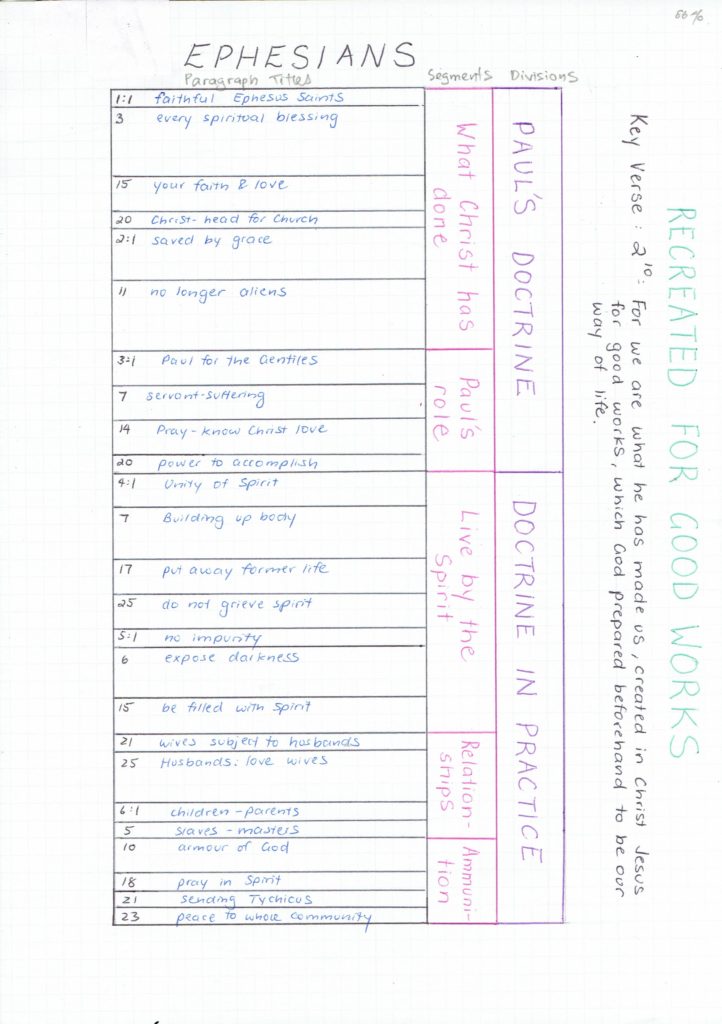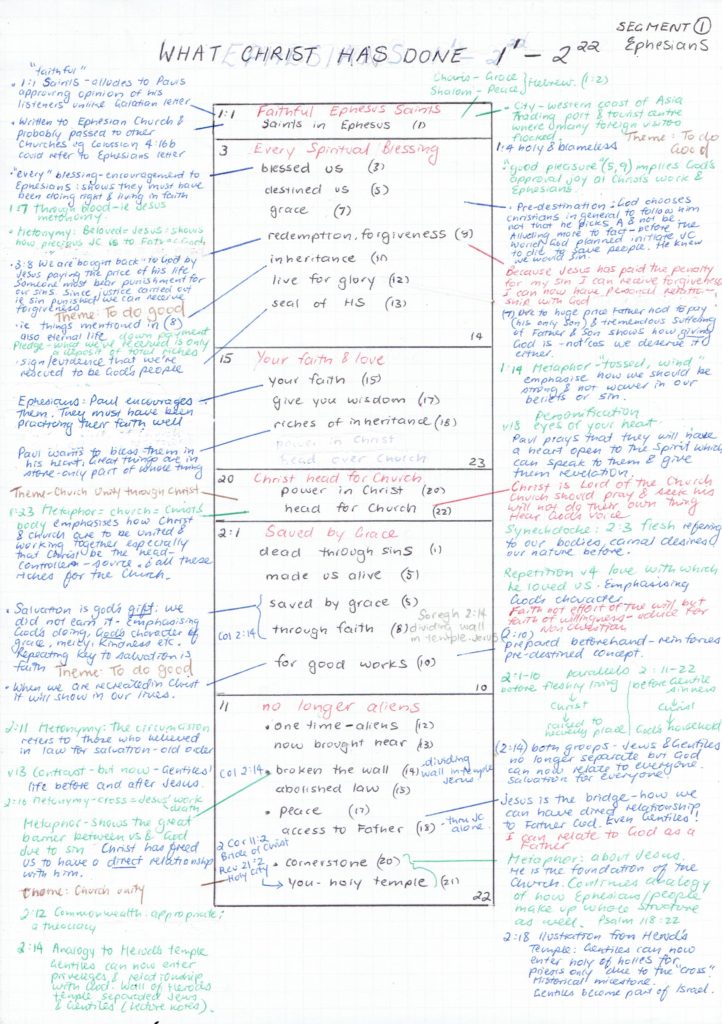How to Study & Apply the Bible Effectively for Your Life
How to Study & Apply the Bible Effectively for Your Life
Studying the scriptures and delving into God’s Word can be the most rich and rewarding things one can ever do. The bible says in Hebrews 4:12 “The Word of God is Living and Active”. It has the ability to come alive, teach us in a vivid and piecing way, revealing truth that penetrates the soul. However when it comes to studying the bible many people are at a loss as to know how to go about this. One way is called the “Inductive Bible Study”method. This aims to look at each book of the bible as a whole then gradually study each section in more detail.
The Inductive Method : is different to other methods in that:-
a) It discovers what the original author was trying to say to his original readers. This author was guided by the Holy Spirit. Therefore if we discover what the original author was saying, we discover what the Holy Spirit was saying.
b) It studies the scriptures in context
c) Conclusions come from observing the text itself
d) It begins with prayer asking God to give us understanding of His Word
e) At the end we ask how the passage in context can apply to our own lives
Purpose: of the Inductive Method is for :-
a) Personal growth and maturity 2 Tim 3: 16-17 and
b) To be able to teach others 2 Tim 2:15 , Hebrews 5:12.
Here are the steps to the Inductive Bible Study Method:-
A) The Big Picture – Horizontal Chart
This step helps gain the big picture or overall theme of the bible book eg. Ephesians.
1. Unmarked Bible: start with an unmarked bible in your chosen Catholic translation
2. Pray: and ask God to illuminate your mind as you undertake this study.
3. Read Whole Book: in one sitting. Read it out aloud or you can listen to it on an app. Don’t stop to ponder but try to acquire the overall picture of the book. The key is to “Observe”.
4. Read & Ask Questions: Read the book again and ask “who what when where and how questions” eg
a) What is the purpose of the book? Sum up the main message
b) What kind of literature is the book and how does this effect it’s interpretation?
c) What are the repeated words phrases and ideas?
d) How does the author build on his argument? What are the main points of his argument?
e) What clues can you find about the historical background in the text?
5. Paragraph Titles: read the text through again and give each paragraph a title. Each title must be 4 words or less and only contain words from the paragraph itself. This enables us to “Observe” first (and do any interpretations at a much later stage).
6. Structure: next is to find the structure that the author used to communicate his message. Do this by reading the text again and looking for compositional links and relationships between paragraphs. Look at your paragraph titles too as a guide. This is hard work and there is no short cut. Give yourself plenty of time. The key is to “Observe” ie. look look & look again.
7. Section Titles: when you have found your groupings, give each segment a title.
8. Division Titles: you can then group your sections into bigger “divisions” and give them titles as well.
9. Key Verse: This is a verse, part of a verse, or a couple of verses within the text that summarises the key message of the book.
10. Book Title: This can be in your own words. It is a short and pithy title that summarise the main message of the book.
11. Completed Chart Example: Later when you look back on it, it will help to remind you of the big picture and theme of the book. This also helps you interpret paragraphs and verses within the context of the whole book.
12. Background Information: The following questions can be obtained from the text itself. If not in the text, one can look up a bible dictionary or other reference book. This information helps to put the book in context of it’s time.
i) Who wrote the book or letter?
ii) When was it written?
iii) To Whom was it written?
iv) From Where was it written?
v) Why was the letter written?
vi) What were the church’s weaknesses? ( if a letter)
vii) What problems were being addressed?
B) Studying the Detail – Vertical Charts
This step helps us study in more detail the verses and paragraphs of the bible book.
1. A4 Graph Paper: Take the first section of your Horizontal Chart eg. “What Christ Has Done”. This will be your first vertical chart. Draw a vertical rectangle in the middle of your graph paper (A4 size). Split this proportionally into your paragraphs. Often one tiny box on your graph paper can equal one verse. Write in your paragraph titles at the top of each box. Also write in the Section title at the top of the page.
The advantage of doing these Vertical Charts is that you can see more clearly how each paragraph relates to each other. They can also be used as teaching tools at a later time.
2. Select Words in Each Paragraph: (black pen). After you have ruled up the vertical chart for your first section, you then select certain words or phrases from the text itself that you would like to study in more detail. Write these words inside your paragraph boxes. You could write these words inside the boxes in black pen. Here is a sample Vertical chart to show how to write the words of the text you have selected inside each box :-
Colour Code
Black –words from each paragraph for selected for further study
Green – Observations
Blue – Interpretations
Red – Applications
Brown – Themes

3. Observations: (green pen) this is a vital step in Inductive Bible Study. It is when we look look and look again to see what the text actually says free from the “baggage” of our own pre-conceived ideas or interpretation. Observations can be derived by asking questions that begin with What, When, Where, How, Why and Who? Examples are:-
a) What :
What events are taking place?
What is the order of these events?
What is being said?
What are the issues being addressed?
What atmosphere do you sense from the different parts of the book?
What moods or emotions do you detect?
b) When:
When was the book written?
Observe the verb tenses: past, present and future
c) Where:
Note the places mentioned
Look up geographical places on a biblical map
Where was the letter sent to?
Where was the author when he sent the letter?
d) How:
How does the author communicate his message?
See also Structure example in Point 11 above.
e) Why:
Bombard the text with why questions.
Why did the author write the letter?
Why did the author need to write the things he did?
Why was the church into the error that they were?
Why does this paragraph follow the last one?
Remember to look for the answers in the bible text first, before seeking commentaries.
f) Who:
Who are the main characters and people?
Note the nouns. Observe who is doing the actions
Observe pronouns: I, he, she, it, they, them, us, who, me, etc
4. Significant Words to Look For :-
a) Contrast : but, even though, much more, nevertheless, yet, although, then
b) Comparison: too, also, as, just as, so also, likewise, and, like
c) Reason/Result: because, for, since, that, so that, in order that, so then, therefore, thus
d) Temporal or time connective : now, until, when, before, after, while, since
e) Condition: if
5. Other Observation Questions :-
a) Are there Repeated Words, Ideas or Themes?
b) Are there Key Words ?
You can write the answers to these observations outside your vertical chart in a different colour pen to distinguish them eg. green pen.
C) Interpretation: (blue pen). Once you have made certain observations from the text (eg. in green pen), it is only then you can write down your interpretations in a different colour (eg. blue pen). Keep asking the Holy Spirit to guide you and give you understanding during this stage.
a) Questions you can ask are:-
– What does the passage mean?
– What did the writer intend for his first readers to understand by what he had written? OR
– What did the first readers understand the writer to mean?
b) Tools for Interpretation : The following 4 questions can assist in the correct interpretation of the text
(i) What kind of LITERATURE is this?
(ii) What is the basic STRUCTURE of the book ?
(iii) What is the HISTORICAL BACKGROUND?
(iv) What are the MEANINGS of various terms and words?
(i) Literature : There are 2 main types
(a) Poetry – language of the heart and feelings
(b) Prose – language of the head and thoughts
(c) Different Kinds of Prose
– Law – eg. Deuteronomy
– Historical Narratives – eg. Chronicles
– Drama – eg. Job
– Proverb – guides only
– Prophetic – eg. Isaiah “Thus says the Lord”
– Gospel – eg. Matthew – to reveal Jesus as the Son of God
– Letter – eg Timothy – written to a certain person or a church
(ii) Structure: the significance of structure is that:-
– the author has constructed his work in such a way as to convey the message
– the structure is like the skeleton on which the flesh hangs
– the individual passages need to be seen in relation to the whole
Eg. Acts -Key Verse is Acts 1: 8.
Structure is :- The Expansion of the Gospel into :-
– Jerusalem
– Judea
– Samaria
– Ends of the Earth
8 Kinds of Structure
1. Geographical – Places (Joshua, Acts)
2. Chronological – Time & Events (Genesis, Exodus)
3. Biographical – Persons (Judges, Ruth)
4. Topical – Ideas (Jeremiah , Matthew)
5. Logical – Ideas, progression of thought (Romans, Galatians)
6. Anthology – Collections (Proverbs)
7. Drama – (Job, Revelation, Song of Solomon)
Letter Structure
1. Name of Writer
2. Name of Recipient
3. Greetings / Blessing
4. Thanksgiving and / or prayer
5. Body of Letter
6. Final Greetings / Benediction
7. Brief autograph (since letter written by scribe)
Laws of Composition
1. Comparison : Alike (Romans 7:1-6)
2. Contrast : Unalike ( Acts 4: 36-5:1)
3. Repetition : The word ‘holy’ in Leviticus. Paul’s testimony in Acts – 3 times
4. Principality : Emphasis and de-emphasis . (Attention to what is stated and what is not). Note the amount of space devoted to the last week of Jesus’ life on earth.
5. Continuity: Progression (Similar to repetition, but with some variation). Eg. Luke 15 – the three “lost” parables
6. Climax : Everything builds to a high point. Eg Job, Revelation, Ecclesiastes
7. Radiation: Central point or theme and everything ties into it. Eg. Philemon v10 Philippians 2:1-11
8. Interchange: Topic begins with subject A, goes on to subject B, then back to subject A again. Eg. Luke 1-3
A. John’s birth B. Jesus’ birth C. John born D. Jesus born
Another example is chapters of 1 Samuel
9. Cruciality: Pivot or turning point eg. Mark 8: 27-30, 2 Samuel between chapters 11 & 12
10. Interrogation : Asking questions eg. Romans 6-7
(iii) Historical Background: here we seek to build the circumstances or occasion for the document. What was the situation into which it was written? Eg. when Nero was persecuting Christians in Rome, Paul wrote the letter to encourage the believers to keep up the faith so they will receive God’s eternal reward in heaven.
Questions to ask:-
1. Who was the author?
2. When was it written?
3. From where was it written?
4. To where was it sent?
5. What was the purpose or the occasion of the document?
There are 2 stages to this:-
1. Internal Evidence: what can we learn from the book itself?
2. External Evidence: what can we learn from other sources? I) Inside the Bible II) Outside the Bible
(iv) Meanings : What does this word mean in context?
What did the writer mean by the phrase he uses?
How do the sentences and paragraphs relate together?
Figures of speech: it is well to note that the bible uses many figures of speech. This can help to interpret certain words or passages correctly eg.
1. Simile: direct comparison of 2 things that are essentially different. Uses words like as or so. Eg. James 1:10 ”they will pass away like a wild flower”
2. Metaphor: Indirect comparison of 2 things. Asserts that one thing IS another. Eg. Matthew 3:7 “you brood of vipers”
3. Allegory: an extended metaphor that has the form of a story eg. the Narnia books
4. Analogy: a more full comparison , showing several points of similarity between unlike things. Eg. John 15:1-9 “vine and branches”
5. Irony: implies something different even opposite of what is stated. Used for effect of humour or sarcasm.
eg. 1 Corinthians 4:8 “ Already you have all you want! Already you have become rich! You have begun to reign—and that without us! How I wish that you really had begun to reign so that we also might reign with you!”
6. Personification: attributing life or human qualities to inanimate objects eg. Proverbs 9:1-3 “Wisdom has built her house she has set up its seven pillars”
7. Apostrophe: speaking to things, abstract ideas or imaginary objects eg. 1 Corinthians 15:55 “O death where is thy sting?”
8. Hyperbole: exaggeration , not to deceive but to emphasise a point eg. Mark 9:43 “if your hand causes you to sin cut it off”
9. Rhetorical Questions: questions which the author does not expect an answer. Used to press home a point. Eg. Matthew 7:16 “ Are grapes gathered from thorns?”
10. Litotes: understatement. Often used as irony. Eg. Acts 15:2 “no small” discussion
11. Metonymy: the substitution of one term for another eg. Romans 3:30 saying the “circumcised” instead of the “Jews”.

12. Synecdoche: part of something is mentioned but the whole is meant eg. Galatians 1:16 “do not confer with flesh and blood”
13. Idiom: an expression belonging to a particular language that cannot be guessed from the actual words.eg Matthew 13:31-32 “as small as a grain of mustard seed”. This was a saying in that original language even though it was not actually the smallest seed that ever existed.
14. Euphemism: a mild expression for something that may sound offensive eg. Genesis 4:1 – “Adam knew Eve“ really meaning they had sexual relations.
D) Application: (red pen) the goal of all bible study. These questions are designed to help us apply the truths we have discovered to our own lives. 5 questions to ask:-
a) What are the basic truths in this passage of the book?
b) How does this truth apply to my life? Be specific
c) In view of these truths what changes do I need to make in my life?
d) How do I plan to carry out these changes?
e) What is my personal prayer regarding this truth and changes I need to make?
Pitfalls in Application: that one should be aware of:-
a) Mistaking interpretation for application
b) Having an emotional response to a biblical truth but not following through to put it into action
c) Frustration in not seeing quick results and changes in your life
How to apply your interpretations can be made in red pen on your vertical charts.
Conclusion: The whole method of Inductive Bible Study may seem overwhelming at first. However the solution is just to digest one small part at a time. When you take the time to pray and analyse each part for yourself, you will find it will all make sense. A summary of the main elements of the inductive method can be made as follows:-
a) Prayer– asking for God’s illumination
b) Observations: this is like the fact finding mission from the text itself
c) Interpretation: what was the original writer trying to say to the original readers of that time?
d) Application: in light of the context, how can I apply this same message correctly to my own life?
e) Prayer – ask God to help you apply these truths in your own life and how to do this.
Another key to Inductive Bible Study is asking good questions. If you find the right questions it can really open up the bible for your heart mind and soul. It is almost like entering another world into biblical times.
Source: Article adapted from study notes – School of Biblical Studies – Youth With a Mission – Canberra
